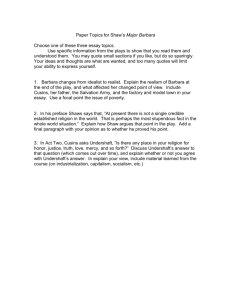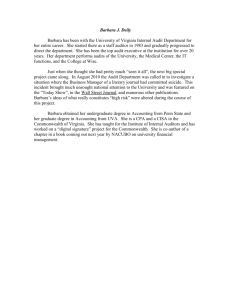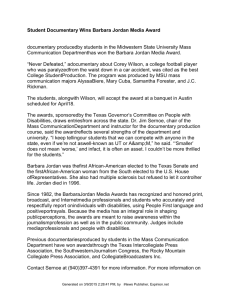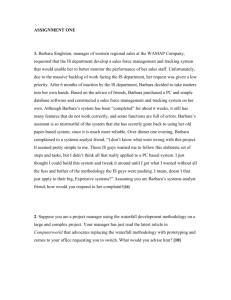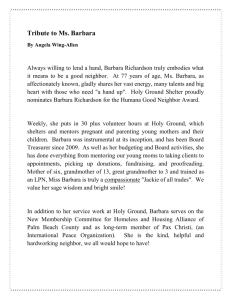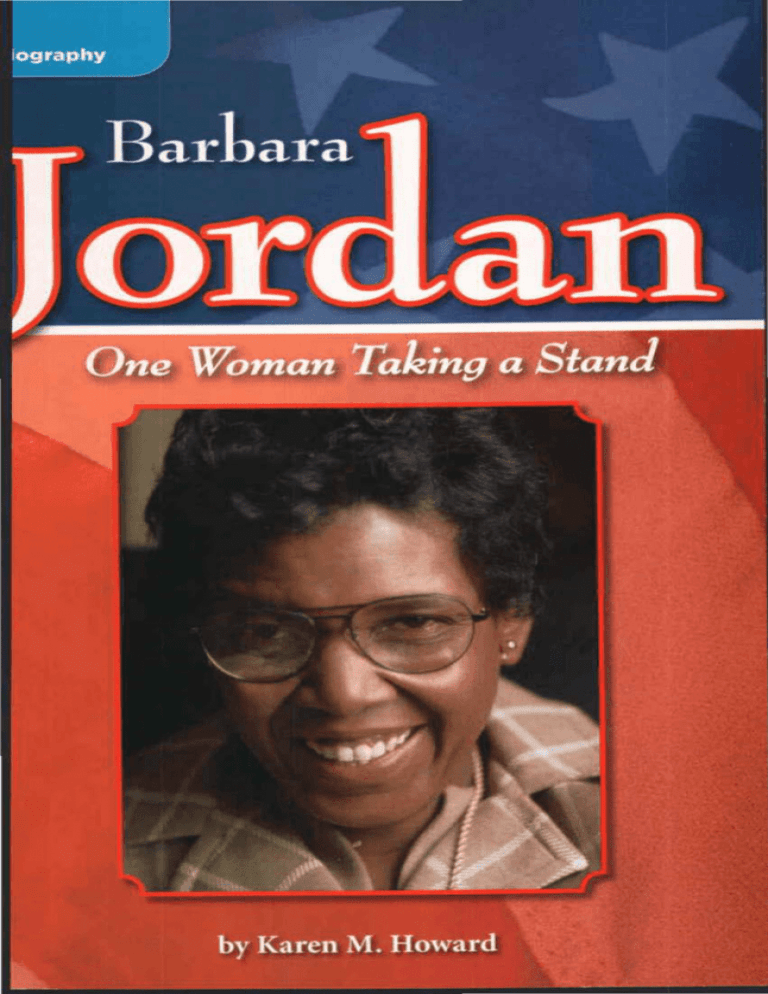
-
-
-
-
-
-
-
-
-
-
STRATEGIES & SKILLS AT A GLANCE
Read to
I
Find Out
I
•
people admire
•
Strategy: Monitor Comprehension
•
Skill: Summarize
•
I
Barbara C. Jordan?
I
•
Vocabulary
Why do so many
�
Comprehension
convictions, defiance, evident,
momentum, oppressed, persistent,
I
remedies, resonated
I
Why is it important
I
to learn about her
Vocabulary Strategy
•
remarkable life?
•
I
I
I
•
•
�
llj;;;::_. .. _
-
- ··:-.
·-
-·
•.
:..
#
photo credits COVER: (bkgd) S Wanke/PhotoLink/
Getty Images; (b) Shepard Sherbeii/CORBIS SABA
1: (c) AP Photo. 2: (b) Owen Fronklin/CORBIS; (bkgd)
Context Clues
CONTENT-AREA VOCABULARY
Words related to Barbara Jordan and
government
(see glossary)
S.Wanke/Photolink/Getty Images. 3: (bl) Carl
Mydons/Time Life Pictures/Getty Images 4: (be)
S,Wonke/PhotoLink/Getty Images; (br) Bettmann/
CO RBIS. 5: (tc) S.Wanke/PhotoLink/Getty Images;
(tr) Bettmann/CORBIS. 6: (b) Bettmann/CORBIS.
CONTENT STANDAR DS
7: (tr) Earlie Hudnall, Texas Southern University
Social Studies
Photographer. 8: (br) Bettmann/CORBIS. 9: (be)
S Wanke/PhotoLink/Getty Images II: (tc) CORBIS
•
12: (be) S Wanke/PhotoLink/Getty Images 14: (b)
Culture
Bettmann/CORBJS; (bkgd) S.Wanke/PhotoLink/Getty
Images. 15: (tr) AP Photo. 17: (cr) Shepard Sherbell!
CO RBIS SABA 18: (br) William J Clinton Presidential
Library. 19: (t) S.Wonke/PhotoLink/Getty Images. 20:
(b) AP Photo/Wilfreda Lee. 21: (br) Courtesy of the
City of Austin Aviation Department; (bkgd) S.Wanke/
PhotoLink/Getty Images.
Word count: 1,910**
B
The McGraw·H/11 Compames
B
B
Macmillan
McGraw-Hill
Published by Macmillan/McGraw-Hill, of McGraw-Hill Education, a division of
The McGraw-Hill Companies, Inc., Two Penn Plaza, New York, New York 10121.
Copyright© by Macmillan/McGraw-Hill. All rights reserved. No part of this publication
may be reproduced or distributed in any form or by any means, or stored in a database or
retrieval system, without the prior written consent of The McGraw-Hill Companies, Inc.,
including, but not limited to, network storage or transmission, or broadcast for distance
learning.
Printed in the United States of America
5 6 7 8 9 026 10 09 08
**The total word count is based on words in the running text and headings only.
Numerals and words in captions, labels, diagrams, charts, and sidebars ore not included.
Barbara
or
an
One Woman Taking Stand
a
by Karen M. Howard
Table of Contents
Introduction
.
.
.
.
.
.
.
.
.
.
.
.
.
.
.
.
.
.
.
.
.
.
.
.
.
.
.
.
.
.
.
.
.
.
.
.
.
.
.
.
.
.
.
.
.
.
.
.
.
.
.
.
.
.
.
.
.
.
.
.
.
.
.
.
.
.
.
.
.
.
.
.
.
.
.
.
.
.
.
.
.
.
.
.
.
.
.
.
.
.
.
.
.
.
.
.
.
.
.
.
.
.
.
.
.
.
.
.
.
2
Chapter One
Growing Up in Texas
3
Chapter Two
Changing Times
.
.
.
.
.
9
Chapter Three
Speaking for the People
13
Chapter Four
A New Career
Conclusion
Glossary
Index
.
.
.
.
.
.
.
.
.
.
.
.
.
.
.
.
.
.
.
.
.
.
.
.
.
.
.
.
.
.
.
.
.
.
.
.
.
.
.
.
.
.
.
.
.
.
.
.
.
.
.
.
.
.
.
.
.
.
.
.
.
.
.
.
.
.
.
.
.
.
.
.
.
.
.
.
.
.
.
.
.
.
.
.
.
.
.
.
.
.
.
.
.
.
.
.
.
.
.
.
.
.
.
.
.
.
.
.
.
.
.
.
.
.
.
.
.
.
.
.
.
.
.
.
.
.
.
.
.
.
.
.
.
.
.
.
.
.
.
.
.
.
.
.
.
.
.
.
.
.
.
.
.
.
.
.
.
.
.
.
.
.
.
.
.
.
.
.
Comprehension Check
17
21
22
23
24
Introduction
Do you know what makes a person unforgettable? Is
it how much money she has or the clothes she wears?
The people we remember are the ones who make a
difference. They are the people who are always thinking
of others. They put others first and stand up for what
they believe.
Barbara Jordan was a woman like that. America
1s a better place because of her. She fought for civil
rights. She fought for women's rights. She used her
gift for speaking to talk about justice. And people
listened. Barbara Jordan captured the American
dream and helped others capture it, too.
0 Everyone from students to
presidents admired Barbara
Jordan.
Here she is with
President Jimmy Carter.
CHAPTER
ONE
Growing Up in Texas
Barbara Jordan was born in Houston, Texas, on
February
21, 1936.
Her neighborhood was mostly
African American.
The youngest of three girls, her full name was
Barbara Charline Jordan. Arlyne, her mother, took
care of the children, while her father, Benjamin,
worked as a clerk. He was also a minister. Every
Sunday the family heard Benjamin preach. His words
resonated within the church. Everyone in the room
could hear his rich voice. His words grew within
Barbara's heart.
<: Buffalo Bayou
was just south
of Barbara
Jordan's
childhood home.
It was named
for the buffalo
that used to
roam nearby.
3
Barbara Jordan lived at a time when black people
and white people had to live apart. This was called
segregation. At the drug store she would see white
children sitting at the counter. They were eating
hamburgers and drinking sodas. She never thought
about trying to sit with them. As a child, Barbara
didn't think about civil rights.
At the time everything in the South was separate.
All the black children went to school together. Black
schools were not as nice as the ones white children
attended. Barbara and her classmates had old books
instead of new ones. But the teachers worked hard to
make sure the children got a good education.
Jim
C·
w
Laws
After the Civil War, states in the South
passed a set of laws called Jim Crow
laws. These laws segregated black
people and white people. African
Americans had separate schools,
bathrooms, theaters, and hotels. The
1964 Civil Rights Act made Jim Crow
laws illegal.
4
Famous
mericans
Phillis Wheatley (c. 1754-1784)
Phillis Wheatley was kidnapped in
West Africa in 1761 and brought
to Boston. She was sold as a slave
to John and Susannah Wheatley.
The Wheatleys encouraged Phillis
to learn to read and write. She
was the first African American
to publish a book of poems
in America.
The Jordan family was close. Both of Barbara's
grandfathers lived with the Jordans. Barbara was
very close to her mother's father, John Ed Patten.
Grandfather Patten taught Barbara to do things for
herself. He taught her to think for herself. And he
opened the world of books to his granddaughter.
Barbara spent most of her free time with
Grandfather Patten. He liked to talk about books,
and she liked to talk about school. At Phillis
Wheatley High School, Barbara made good grades
and was an honor student. Her love for the English
language led her to join the debate team. She
enjoyed arguing about ideas.
5
In high school, it became evident that Barbara
Jordan was an excellent public speaker. She often
debated and spoke in public. In
1952
she won her
first match as an orator! Next Barbara went to a
national orator's competition in Chicago, and she
won first place.
One person who greatly inspired Barbara was
Edith Sampson, a famous African American lawyer.
She spoke at Barbara's high school about how lawyers
helped others. Her speech inspired Barbara to become
a lawyer.
0 Edith Sampson (1901-1979) was the first African
American woman to become a United States judge.
6
But Barbara's first mentor
was her mother. She
looked up to her
mother as a role
model. And it's
clear that Arlyne
and Benjamin
Jordan's love for
the spoken word
was catching.
Wanting to make
her mother proud,
Barbara worked
hard in high school
and graduated with
honors. Then
0 Dr. Thomas Freeman also
taught Martin Luther King, Jr.
she decided to go to
Texas Southern University (TSU).
When Barbara first arrived at TSU, she joined
the debate team. She thought her diction was
perfect. But Dr. Thomas Freeman, the debate
coach, thought Barbara could do better. He took
the time to work with his new student, and
Barbara's skill as a debator and public speaker
improved. In 1956 she graduated from TSU with
high honors.
7
Barbara Jordan held on to the convictions of her
youth and went to law school in Boston. She was far
from home. Barbara was one of only two African
American women in the law school. At times she
felt lonely, but her family's persistent love and faith
in her made her determined to finish school. She
graduated in
1959.
After law school Barbara returned to Houston.
She started her law practice in her parents' kitchen.
People would come to the
Jordan house with their
legal problems. Barbara
had remedies for most
of them and was able to
solve their problems. She
practiced law at home for
three years. Then because
her clientele was growing
so much, Barbara moved
into an office in the
neighborhood.
Barbara Jordan was
happy and successful
at T SU, but she had
hoped to go to the
University of Texas at
Austin. She couldn't
because of segregation.
8
:)
CHAPTEH
TWO
Changing Times
Barbara was beginning to look at things
differently. While at school in the North, she had
been treated fairly. Now the segregation that hadn't
bothered Barbara in her youth made her feel
uncomfortable. She realized that things needed to
change. And Barbara wanted to make those changes.
The year was
1960.
John F. Kennedy was running
for president as a Democrat. Texan Lyndon B.
Johnson was running as his vice president. Barbara
believed these two men would change the laws that
oppressed minorities. During their presidencies,
African Americans won important victories.
"
Famous
meridans: Lynd on B.
J ohnson
Lyndon B. Johnson grew up in Texas. Like Jordan,
he knew what it was like to be poor. His political
career began in 1937 when he was elected to serve
in Congress. As president, he signed the Voting Rights
Act and the Civil Rights Act. Barbara Jordan advised
.
�
President Johnson on civil rights .
9
The election of Kennedy and Johnson in
1960
gave Barbara momentum. More than ever, she wanted
to make sure everyone in the United States had a
voice. Change was on the way, and Barbara Jordan
wanted to be part of it. It was a time of great hope.
The civil rights movement grew stronger. African
Americans were tired of poor treatment. They
wanted equal rights. Barbara decided it was time
to act. She became a leader in the Harris County
Democratic Party.
r
r
�
Milestones in the Civil
Rights Movement
"'
'I
1954
Supreme Court rules against
the segregation of public schools.
1955
Rosa Parks refuses to give up
her seat on a bus. Her act brings
more attention to the civil
rights movement. Segregation
on interstate buses is banned
later that year.
1960
Four African American students
ask to be served at a lunch
counter. Soon students all over
the country do the same,
strengthening the civil
rights movement.
�
'
10
1963
About 200,000 listen
to Martin Luther King's
"I Have a Dream" speech
at a march on Washington, D.C.
1964
President Johnson signs
the Civil Rights Act of 1964.
1965
Congress passes the
Voting Rights Act of 1965.
This means that all citizens
can vote, no matter what
their race is.
II
../
0 Barbara Jordan earned the respect of the other Texas
senators and representatives.
Then in
1962
Barbara ran for the Texas House
of Representatives. She lost. She ran for the Texas
House again in
1964.
She lost again. But Barbara
was persistent. She didn't give up. In
1966
she ran
for the Texas State Senate-and won. She became the
state's first African American senator since
1883
and
the first woman to serve in the Texas State Senate.
Barbara Jordan worked hard for the people in
her state. She helped all Texas workers receive a fair
wage for their work. She also fought for clean air.
11
In
1972
Barbara Jordan was elected to the U. S.
House of Representatives. She was the first African
American representative from Texas. She was also the
first African American woman from the South to
serve in the House of Representatives.
In Congress Barbara wrote bills to help the poor.
She also wrote bills to help women. Because of the
Voting Rights Act of
1965,
more people could vote.
Still, many groups of people didn't have that right.
Barbara fought to give Native Americans, Hispanics,
Alaskan natives, and Asian Americans the right
to vote.
Life was getting better for Americans of color.
However,
1974
was a bad year for this country.
President Richard Nixon was caught in a political
scandal. It was called Watergate.
Watergate
In the summer of 1972, five men were arrested at the
Watergate Hotel in Washington, D.C. They were trying
,I
to "bug" or place listening devices in the offices of the
Democratic National Committee. The men were working
for CREEP (Committee to Re-elect the President).
President Nixon tried to stop the investigation into
-
the break-in.
12
CHAPTER
THR EE
Speal�ing for the People
On June
17, 1972,
people broke into the National
Offices of the Democrats in Washington. They stole
important documents. This was illegal. Who had
hired these people?
The burglars worked for a group that wanted
to re-elect President Nixon. President Nixon tried
for years to cover up the connection to the
White House.
Barbara believed President Nixon knew about the
break-in. She called for his impeachment, charging
him with behaving improperly. Barbara believed the
American people had the right to know the facts.
On July
25, 1974,
Barbara gave a powerful speech.
She talked about how the Constitution was the law
of the land, and even the president had to obey it.
President Nixon resigned later that year.
13
"Earlier today,
we heard the beginning of the
Preamble to the Constitution of the United States,
'We, the people�
.
. . My faith in the Constitution
is whole, it is complete,
it is total. I am not
going to sit here and be an idle spectator to
the destruction of the Constitution."
-From Barbara Jordan's 1974 speech calling for
President Nixon's impeachment
At the 1976
�
Democratic
Convention
Barbara Jordan
nominated
Jimmy Carter
for president.
Although Barbara was a rising star in the
Democratic Party, her health was failing. She had
multiple sclerosis. The illness sometimes made it
hard for her to walk. But she continued to fight for
civil rights for everyone. There were even rumors
that Barbara Jordan might become the first female
president of the United States.
By
1976
her failing body was becoming more
and more visible. She began to use a wheelchair
because her muscles were weak. It was difficult for
her to stand. Nevertheless, in defiance of her poor
health Barbara spoke at the Democratic National
Convention. Here is part of what she said. "There
is something special about tonight. What is
different? What is special? I, Barbara Jordan,
am a keynote speaker."
15
What did she mean about the night being special?
No other African American had ever spoken at a
major political convention. The night wasn't just
special for Barbara Jordan or the Democrats. It was
special for every American. She was an example of
what every child in the United States could become.
Her inspiring message of equality made the
night special.
Jimmy Carter was elected president. He asked
Barbara to be America's voice at the United Nations.
It was an honor, but she said no. President Carter
also considered her for Attorney General. Although
Barbara Jordan might have liked being the lawyer for
all Americans, she decided it was time to go home.
Barbara jordan's
Political Accomplishments
1966
Elected to Texas
State Senate
1968
Wins 2nd term
in State Senate
16
1972
Elected to U.S.
House of
Representatives
1976
Delivers keynote
speech at Democratic
National Convention;
wins 3rd term
in Congress
1974
Gains national recognition
during the impeachment
hearings; elected to
2nd term in Congress
1979
Becomes professor
at the Lyndon B.
Johnson School of
Public Affairs at the
University of Texas
CHAPTER
FOUR
A New Career
In
1979
Barbara Jordan went back to Austin to
teach at the University of Texas. She taught at the
Lyndon B. Johnson School of Public Affairs. This
was the same university Barbara had wanted to
attend in
1952.
Because of segregation, she hadn't
been able to enter the university. Twenty-seven
years later, she was teaching there. The country
had changed.
In addition to teaching,
Barbara advised students
about their courses. She
helped bring minority
students to the
university. The door
once closed to her
was now open
to others.
0 Barbara Jordan was a
popular teacher at the
University of Texas.
17
Barbara Jordan remained deeply interested in
politics. Bill Clinton asked her to speak at the
1992
Democratic Convention. She felt that it was an honor
to nominate him for president.
Two years later President Clinton gave the
Presidential Medal of Freedom to Barbara Jordan.
In his speech he said she was a woman who led
by example. He said she earned America's lasting
respect. Then the president placed the medal around
her neck.
The Presidential
Medal of Freedom
is one of the
highest h onors an
Am erican civilian
can receive.
18
!)
Awards
During her lifetime, Barbara Jordan received many
awards, including the following:
I'
Induction into African American Hall of Fame
Elected to Texas Women's Hall of Fame
Voted "Best Living Orator" by the International
Platform Association
Named "One of the 25 Most Influential Women in
America" for 12 years in a row
Spingarn Medal from the NAACP for service to the
African American community
Presidential Medal of Freedom
In her later years Barbara Jordan stayed busy.
She gave speeches. Thirty-one schools awarded her
special degrees. Her autobiography, Barbara Jordan:
Self Portrait, was published in
1979.
A
Barbara's mind
was still sharp. But her body kept failing. Doctors
found out that she had leukemia. Barbara Jordan
died on January
17, 1996.
It was a month before
her sixtieth birthday.
Barbara Jordan loved life. And she had done what
Grandfather Patten taught her to do. She had made
her own path.
19
Barbara Jordan's funeral was held in the Good
Hope Baptist Church. The Good Hope is where her
parents first met. Over
1,000
mourners came to
say goodbye to her.
President Clinton spoke at the funeral. He told
the crowd, "When Barbara talked, we listened." Then
he said, "Barbara Jordan made every one of us stand
a little straighter, speak a little clearer, and be a
little stronger."
Barbara's friend former Texas Governor Ann
Richards said she was as true as the North Star. She
called Barbara Jordan a national treasure. Barbara's
students spoke, too. Many said she was their hero.
What we should remember is that Barbara Jordan
dedicated her life to fighting for equality and
civil rights.
0 President Clinton spoke at Barbara Jordan's funeral.
Conclusion
Barbara Jordan earned the respect of America.
She was born poor. She was an African American
woman in the South who grew up during
segregation. Barbara Jordan didn't let anything keep
her from helping others. She went to law school. She
served the people of Texas in Congress.
Barbara Jordan asked a question that
we still need to ask today: "Who
then will speak for America? Who
will speak for the common good?"
In 1997 th e term inal
at th e airport in
Austin, Texas, was
named after
Barbara Jordan.
:>
Glossary
bill (BtL) a suggested law (page 72)
civil rights (SIV-uh/ RIGHTS) the rights of every citizen of a
country, including the right to vote and the right to equal
protection under the law (page 2)
clientele (kligh-uhn-TEL) the people who seek the services of a
professional person, such as a lawyer (page 8)
debate (dee-BAYT) a discussion involving opposite points of
view about a topic (page 5)
diction (0/K-shuhn) speech that is clear; the speaker
pronounces words in a precise way (page 7)
impeachment (im-PEECH-muhnt) a charge that a public official
has behaved improperly (page 73)
keynote speaker (KEE-noht SPEE-kur) the first person to
address a political convention and outline the issues to be
considered (page 75)
mentor (MEN-tawr) a wise and trusted teacher (page 7)
multiple sclerosis (MUL-ti-puhl sk/uh-ROH-sis) a chronic disease
that affects the nervous system (page 75)
orator (AWR-uht-ur) a skilled public speaker (page 6)
scandal (SK AN-duhl) an event that shocks people and brings
disgrace (page 72)
segregation (seg-ruh-GAY-shuhn) the practice of separating
groups of people because of race (page 4)
senator (SEN-uh-tur) a member of a state senate or the United
States Senate (page 77)
22
Index
autobiography, 79
Parks, Rosa, 70
Carter, Jimmy, 2, 75, 76
Patten, John Ed
Civil Rights Act of 1964, 4,
9, 70
Clinton,
Phillis Wheatley High
Bill, 78, 20
Constitution, 73-74
Democratic National
Convention, 75, 76, 78
Democratic Party, 9-70,
75, 78
Freeman, Thomas, 7
House of Representatives,
72, 76
impeachment, 73, 76
Jim Crow laws, 4
Johnson, Lyndon B., 9-70
Jordan, Arlyne (mother),
3, 7
School, 5-6
Presidential Medal of
Freedom, 76, 78, 79
Richards, Ann, 20
Sampson,
Edith, 6
segregation, 4, 9, 70, 77, 27
Texas, 8, 9, 77, 20, 27
Austin, 77
governor, 20
Harris County, 70
House of
Representatives, 77
Houston, 3, 8
Senate, 77,
Jordan, Benjamin (father),
3, 7
76
Texas Southern University,
7
Kennedy, John F., 9-70
King,
(grandfather), 5, 79
Martin Luther, 70
law practice, 8
Lyndon B. Johnson School
of Public Affairs, 76, 77
multiple sclerosis, 75
Nixon, Richard, 72-74
University of, 77
United Nations, 76
United States Congress,
72, 76, 27
Voting Rights Act of 1965,
9, 70
Watergate, 72-73
23
Comprehension Check
Summarize
Use a Plot Summary Chart
to help you retell key
Summary
events in Barbara Jordan's
life. Why do you think
the author chose to write
about Barbara Jordan?
Think and Compare
1. Turn to page 6. The author states that Barbara
Jordan developed the goal of helping people. Did she
achieve her goal? Support your ideas with information
from the text. (Summarize)
2. Barbara Jordan spent her life tr ying to help people.
How could you make life better for someone? (Apply)
3. Some people think that the civil rights movement is
over because there are no more problems to solve.
What do you think? (Analyze)
24
Express Your Point of View
Think about a topic that you feel strongly
about, such as recycling or animal rights.
Write a speech expressing your point of view
on the topic. Then write a speech that takes
the opposite viewpoint.
Know Your Representatives
Barbara Jordan served in the United States House
of Representatives. She represented people in an
area that included her hometown of Houston. Who
represents you in the House of Representatives?
Who are the senators for your state? What political
parties do they belong to? Where do they stand
on the issues that matter to you? Create political
trading cards to show your information.
ISBN 0 · 02 · 193�27 · 4

